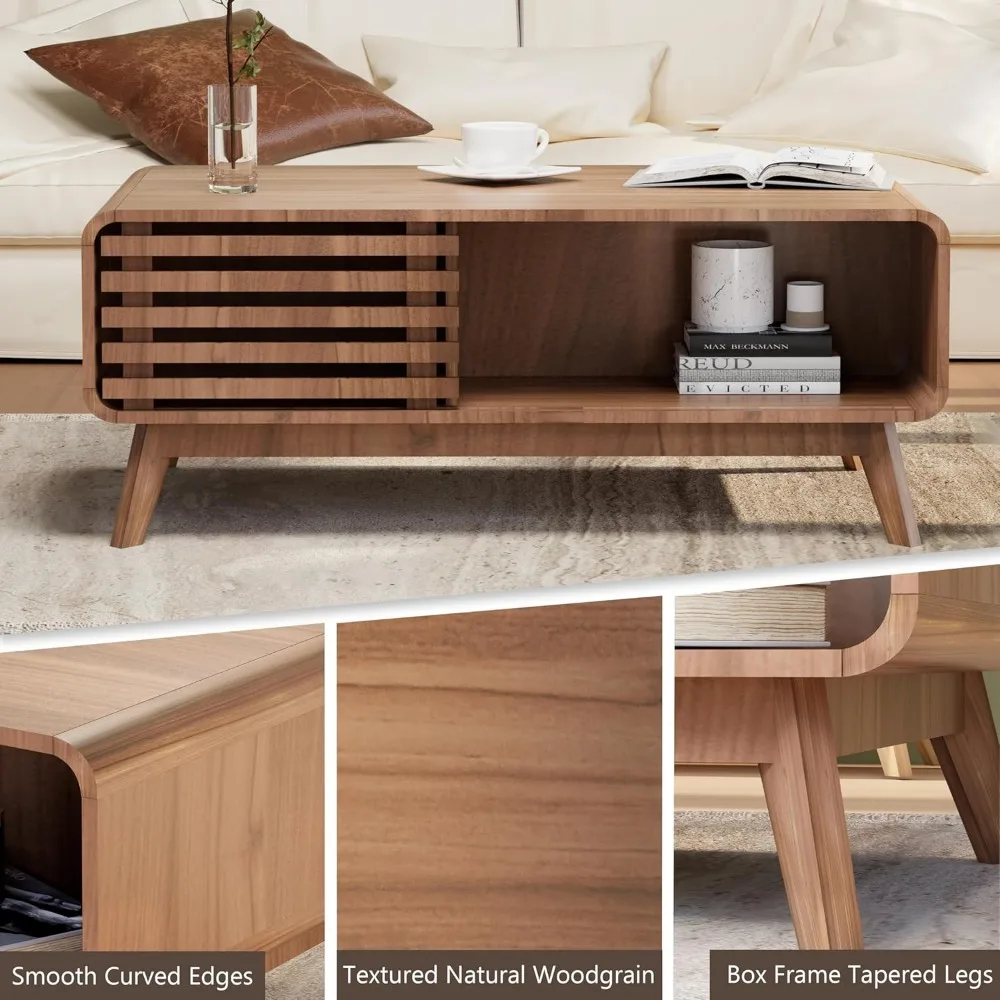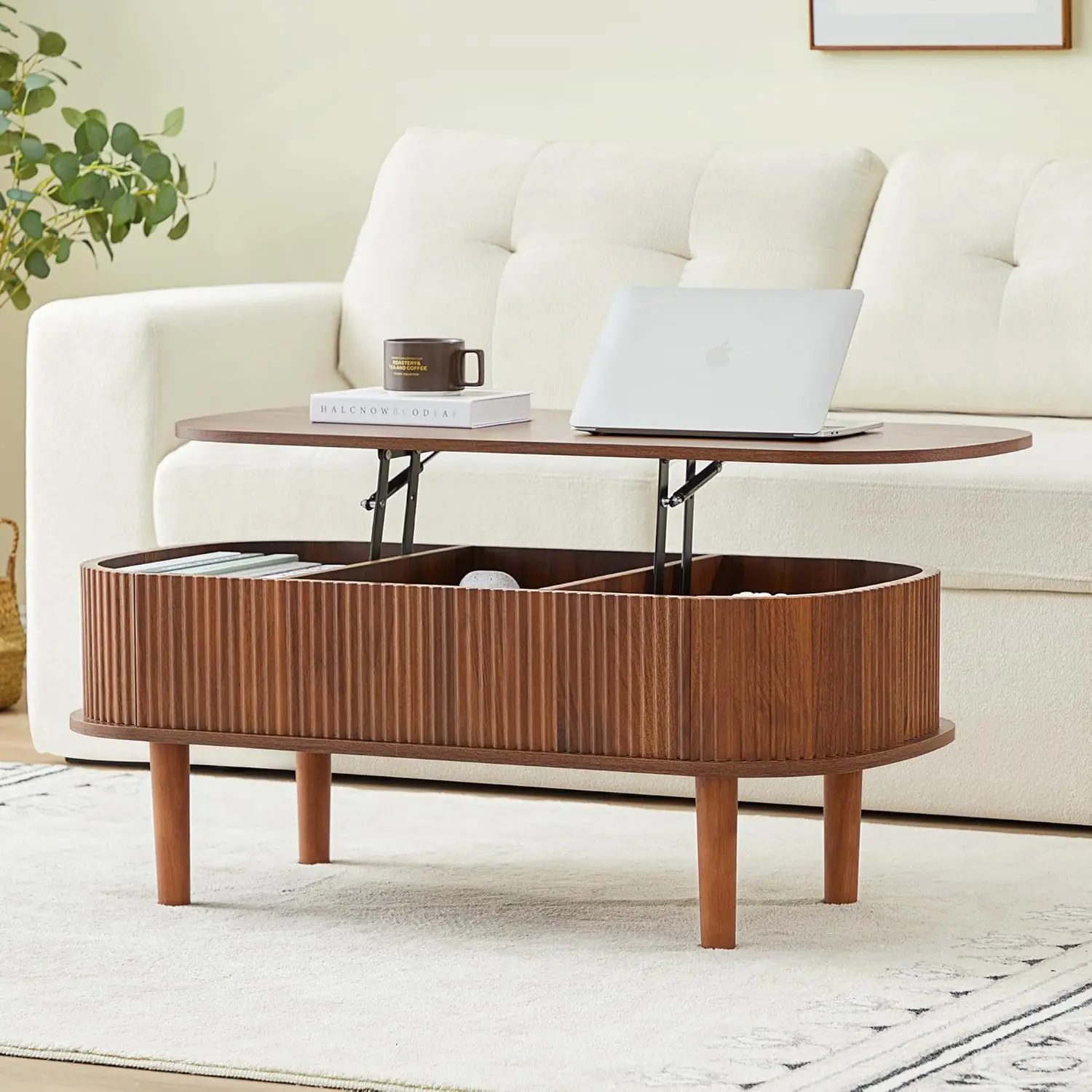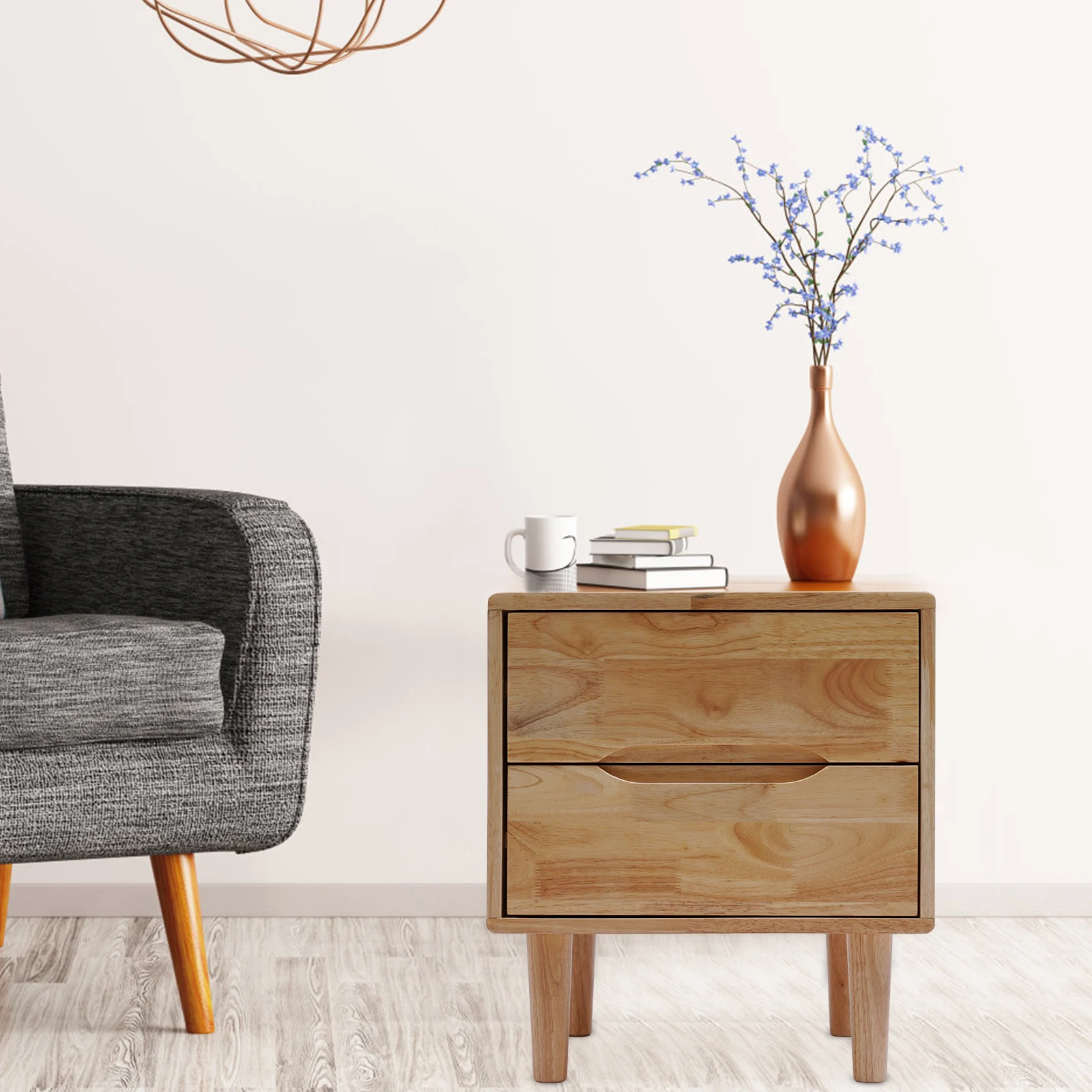1. Introduction: The Timeless Appeal of Teak Wood Grain
Teak wood stands as one of the world’s most distinguished hardwoods, prized for its remarkable grain patterns and exceptional natural properties. This tropical hardwood, scientifically known as Tectona grandis, has earned its prestigious reputation through centuries of use in the finest furniture, architectural elements, and maritime applications.
The distinctive grain of teak tells a story of natural beauty and remarkable durability. Its warm golden-brown tones and characteristic patterns have made it a cornerstone material in fine furniture design, particularly in mid-century modern teak coffee tables and other high-end applications. This enduring popularity isn’t merely aesthetic—teak’s grain structure contributes directly to its legendary durability and resistance to the elements.
Understanding teak’s grain characteristics offers multiple benefits. For buyers, it provides the knowledge to identify genuine quality. For designers and craftspeople, it reveals how to best utilize this premium material. And for collectors and enthusiasts, it deepens appreciation for teak’s natural artistry and functional excellence.
Throughout this guide, we’ll explore the scientific foundations of teak grain formation, its visual and tactile characteristics, and how these qualities translate into teak’s renowned performance in everything from outdoor furniture to fine cabinetry.
2. The Science Behind Teak Wood Grain Formation
Teak’s distinctive grain patterns begin their development long before the wood reaches a furniture maker’s workshop. The formation of this premium hardwood’s signature characteristics starts with the biological processes that occur as the tree grows in tropical forests across Southeast Asia.
Growth Cycle and Ring Formation
Unlike trees in temperate zones that have clear dormant seasons, teak grows in tropical regions with less pronounced seasonal variations. However, teak still forms visible growth rings due to alternating wet and dry seasons. During the rainy season, teak grows rapidly, creating lighter-colored wood. In dry periods, growth slows, producing denser, darker wood. This alternation creates the distinctive banding pattern visible in teak’s grain.
Environmental Influence on Grain Development
The environment plays a crucial role in determining teak’s grain characteristics:
– Trees growing in consistent climate conditions tend to develop more uniform, straight grain patterns
– Those facing variable conditions or growing on slopes often develop more wavy or interlocked grain
– Soil composition affects mineral content within the wood, sometimes creating unique coloration streaks
Plantation vs. Old-Growth Differences
The distinction between plantation-grown and old-growth teak is evident in their grain patterns:
Plantation teak, grown in managed forests with accelerated growth cycles, typically features:
– Wider-spaced growth rings
– Less density overall
– More variability in grain pattern
– Lighter color tones
Old-growth teak, developing slowly over decades in natural forests, displays:
– Tighter, more numerous growth rings
– Greater density and weight
– More uniform and typically straighter grain
– Richer golden-brown color
These differences stem from growth rates—trees that grow slowly develop more compact cellular structures. This explains why solid wood coffee tables made from old-growth teak often command premium prices and demonstrate superior performance characteristics.
The wood’s silica content, natural oils, and other compounds become more concentrated in slower-growing specimens, affecting both appearance and durability. According to the Wood Database, these natural compounds contribute significantly to teak’s exceptional resistance to rot, insects, and weathering.
3. Primary Visual Characteristics of Teak Wood Grain
The visual signature of teak wood is instantly recognizable to furniture enthusiasts and wood connoisseurs. Its distinctive grain patterns create a visual fingerprint that helps distinguish premium teak from other hardwoods and even from lower-quality teak varieties.
Grain Direction Patterns
Teak exhibits several grain direction patterns, each with its own visual appeal and structural implications:
Straight Grain:
– Most common and highly prized in furniture-grade teak
– Runs parallel to the length of the board with minimal deviation
– Creates a clean, orderly appearance prized in black mid-century coffee tables and other fine furniture
– Indicates stable growing conditions and typically superior structural performance
Wavy Grain:
– Shows gentle undulations that create subtle ripple effects
– Adds visual interest and character to furniture surfaces
– Often prized for decorative elements and statement pieces
– Results from varying growth conditions or tree stress during development
Interlocked Grain:
– Grain direction alternates in adjacent growth layers
– Creates distinctive patterns when quarter-sawn
– Adds structural complexity that can enhance stability but makes working the wood more challenging
– More common in certain growing regions and conditions
Irregular Grain:
– Typically appears around knots, branch junctions, or growth anomalies
– Creates unique, one-of-a-kind patterns prized in artisanal pieces
– Often featured in character-grade teak for its distinctive appearance
Growth Rings
Teak’s growth rings provide both visual interest and information about the wood’s origin and growing conditions:
- In cross-sections, rings appear as concentric circles of alternating light and dark bands
- In flat-sawn surfaces, they create cathedral or arched patterns
- In quarter-sawn pieces, they appear as straight, parallel lines
- Tighter, more numerous rings indicate slower growth and typically higher density
- The width and regularity of growth rings reveal information about growing conditions
Figure and Markings
Beyond basic grain direction, teak often displays distinctive figure patterns:
- Mineral streaks that create darker lines or subtle color variations
- Natural figuring such as flame, ribbon, or curl patterns in premium specimens
- Occasional spalting (fungal coloration) that creates unique dark lines in certain pieces
- Small knots and growth variations that add character without compromising structural integrity
These visual characteristics combine to create teak’s unmistakable appearance—warm, inviting, and naturally elegant—making it a favorite choice for everything from mid-century modern classics to contemporary design pieces.

4. How Different Cuts Reveal Teak’s Grain Beauty
The method used to cut teak lumber from logs dramatically influences how its grain patterns are displayed in the finished piece. Each cutting technique reveals different aspects of teak’s natural beauty, making certain cuts more desirable for specific applications.
Flat-Sawn (Plain-Sawn) Teak
Flat-sawing is the most common and economical cutting method, where logs are cut parallel to the growth rings:
- Produces the characteristic “cathedral” or flame-like grain pattern
- Growth rings appear as arched or oval patterns on the surface
- Maximizes yield from each log, making it more cost-effective
- Often selected for large panels and tabletops where dramatic grain patterns are desired
- Tends to exhibit more dimensional movement with humidity changes
- Commonly used in black mid-century coffee table features for its dramatic visual impact
Quarter-Sawn Teak
Quarter-sawing involves cutting perpendicular to the growth rings, revealing a different face of teak’s character:
- Creates straight, parallel grain lines with minimal cathedral patterning
- Exposes medullary rays as small flecks or ribbons of contrasting color
- Provides superior dimensional stability with less expansion and contraction
- Resists cupping and twisting better than flat-sawn lumber
- Often selected for table leaves, drawer fronts, and areas requiring maximum stability
- Typically more expensive due to lower yield and more labor-intensive processing
Rift-Sawn Teak
Rift-sawing strikes a middle ground between quarter and flat-sawing:
- Cuts at approximately 45 degrees to the growth rings
- Creates straight, consistent grain patterns without the medullary ray flecks of quarter-sawn
- Offers good dimensional stability with a more uniform appearance
- Particularly valued for creating consistent grain patterns across multiple pieces
- Often used for furniture components where grain matching is important
End-Grain Teak
Though less commonly featured, end-grain (cutting across the tree trunk) reveals yet another face of teak:
- Displays the concentric growth rings as circular or oval patterns
- Creates a distinctive spotted or dotted appearance
- Offers exceptional wear resistance, making it ideal for cutting boards
- Sometimes used as accent elements in furniture design
- Provides a unique contrast when paired with face grain in the same piece
Understanding these different cuts helps furniture enthusiasts appreciate the thoughtful design decisions in pieces where multiple grain orientations are intentionally combined for both aesthetic appeal and structural integrity.
5. The Rich Palette: Teak Wood Color Variations and Aging
Teak’s color story is as distinctive as its grain patterns. The wood undergoes a fascinating transformation over time, developing a rich patina that many consider even more beautiful than its initial appearance.
Freshly Cut Color Profile
When first cut and processed, teak displays a vibrant palette:
- Fresh heartwood ranges from golden-honey to medium amber-brown
- Surface often has a slightly oily or waxy sheen due to natural oils
- Occasional darker streaks or lighter patches add character
- Sapwood appears distinctly lighter, often pale yellow to tan
- Color variations can indicate regional origin and growing conditions
Many vintage coffee tables showcase how these initial colors have evolved over decades of use and exposure.
Color Evolution Over Time
One of teak’s most valued characteristics is how it ages gracefully:
- With exposure to air and light, teak naturally darkens to a rich golden-brown
- Over several years, it continues to deepen to a warm honey amber
- Surface develops a silky patina through oxidation and handling
- Oil content contributes to a subtle luster that deepens with age
- This natural aging process is highly prized in authentic mid-century pieces
This natural progression makes teak uniquely suitable for black coffee tables in mid-century interiors, where the warm wood tones create beautiful contrast with darker elements.
Heartwood vs. Sapwood Coloration
The distinction between heartwood and sapwood creates important color variations:
- Heartwood (the inner, non-living wood) displays the rich golden-brown tones
- Higher oil content in heartwood provides better natural protection and darker color
- Sapwood (the outer, newer growth) appears significantly lighter
- Premium furniture typically uses heartwood exclusively for consistent color
- The percentage of heartwood is an important grading factor for teak quality
Geographic Origin and Color
Subtle color differences can sometimes indicate the wood’s origin:
- Burmese teak often has a slightly richer, golden-brown tone
- Indonesian teak may display slightly more reddish undertones
- Plantation-grown teak from various regions typically shows lighter coloration
- African-grown teak can have slightly different color characteristics
- Growing conditions affect the concentration of oils and minerals that influence color
These natural color variations contribute to teak’s ongoing popularity in furniture design, where its warm tones complement many interior styles while maintaining a distinctive character all its own.

6. Texture and Tactile Qualities of Teak Wood Grain
Beyond its visual appeal, teak offers a distinctive tactile experience that separates it from other premium hardwoods. These sensory qualities contribute significantly to its enduring appeal in furniture that invites both visual appreciation and physical interaction.
Surface Texture
Teak presents a unique textural profile that furniture enthusiasts immediately recognize:
- Natural, unfinished teak has a moderately coarse but uniform texture
- The grain creates subtle ridges you can feel when running your hand across the surface
- Growth rings provide a gentle rippled texture in flat-sawn pieces
- Quarter-sawn surfaces feel more consistently smooth with less textural variation
- Compared to other hardwoods like oak, teak feels less pronounced in its grain texture
- When properly finished, the surface develops a silky-smooth quality while maintaining subtle textural character
These textural qualities make teak particularly suitable for styling black mid-century coffee tables where both visual and tactile elements create a complete sensory experience.
Natural Oiliness
Teak’s most distinctive tactile characteristic comes from its natural oil content:
- Fresh-cut teak feels slightly waxy or oily to the touch
- This natural oil gives teak a warm, almost leather-like quality
- Higher-quality teak has greater oil content, resulting in a more pronounced silky feel
- Even after decades, well-maintained teak retains this characteristic quality
- The natural oils create a subtle resistance when running your hand across the surface
- This quality is impossible to replicate in substitute woods or synthetic materials
Density and Weight
Teak’s physical presence is immediately apparent through its substantial weight:
- At approximately 41 pounds per cubic foot (655 kg/m³), teak has a medium-heavy weight
- Premium old-growth teak tends to be denser and heavier than plantation-grown
- The weight provides a satisfying solidity that signals quality and durability
- When lifted, quality teak furniture feels substantial without being unwieldy
- The density translates to a pleasing acoustic quality—a solid, subdued sound when tapped
Finishing Response
How teak responds to finishing further enhances its tactile appeal:
- The wood accepts oil finishes readily due to its natural compatibility with oils
- Polished teak develops an exceptionally smooth, satiny surface
- With handling and age, the surface becomes increasingly silky
- Even with minimal finish, teak develops a natural patina from contact with human hands
- Unlike some hardwoods, teak rarely feels “cold” to the touch, instead providing a warm, inviting feel
These tactile qualities create an intimate connection between the user and the material—one reason why teak furniture often becomes more cherished with age and use.
7. How Grain Affects Teak’s Legendary Durability
Teak’s reputation for exceptional longevity isn’t merely anecdotal—it’s directly linked to specific characteristics within its grain structure. These natural properties combine to create a wood that performs remarkably well across decades of use in challenging environments.
Natural Oils and Resins
Teak’s cellular structure contains natural compounds that provide extraordinary protection:
- Tectoquinones and other natural oils distribute throughout the wood grain
- These compounds act as built-in preservatives, repelling insects and preventing rot
- Oil concentration is highest in the heartwood, explaining its superior durability
- Unlike applied finishes that eventually wear off, these natural oils are integral to the wood
- Even as teak ages, these protective compounds remain active within the grain structure
These natural qualities have made teak a preferred material in iconic teak coffee table elements where lasting beauty is essential.
Grain Density and Strength
The physical arrangement of teak’s grain contributes significantly to its structural integrity:
- Tighter growth rings indicate slower growth and typically greater strength
- The interlocked grain pattern in some teak adds structural stability
- Fiber arrangement provides excellent tensile strength along the grain
- Old-growth teak, with its denser grain structure, typically offers superior strength
- Even with seasonal movement, teak’s grain structure helps it maintain dimensional stability
These strength characteristics make teak particularly suitable for decorating with black mid-century coffee tables where durability must match aesthetic appeal.
Weather and Water Resistance
Teak’s extraordinary weather resistance stems from specific grain-related properties:
- Natural oils repel water rather than absorbing it like many other woods
- Silica content within the grain structure provides additional protection
- Tight grain minimizes water penetration even in humid environments
- Oil distribution throughout the wood prevents warping and checking
- These combined qualities allow teak to survive 20-30+ years in outdoor conditions
Pest and Fungal Resistance
The natural chemical composition within teak’s grain provides exceptional biological protection:
- Oils and resins are naturally toxic to many wood-boring insects
- The same compounds inhibit fungal growth that causes rot in other woods
- This protection extends throughout the wood, not just on the surface
- Even untreated teak resists termites and other destructive pests
- The natural resistance eliminates the need for chemical treatments
This combination of protective qualities explains why centuries-old teak structures still stand in Southeast Asia and why vintage teak furniture often remains in excellent condition despite minimal maintenance—a testament to the remarkable protective systems built into every fiber of this extraordinary wood.
8. Working With Teak: How Grain Affects Craftsmanship
Teak’s distinctive grain characteristics create both opportunities and challenges for craftspeople. Understanding these properties is essential for anyone working with this premium material to achieve optimal results in furniture construction and finishing.
Cutting and Machining
Teak’s grain structure influences how it responds to tools and cutting processes:
- The natural silica content in teak quickly dulls cutting tools, requiring frequent sharpening
- Straight-grained teak cuts cleanly with minimal tearout
- Interlocked grain sections require slower feed rates and sharper tools to prevent splintering
- The wood’s natural oils can build up on saw blades and cutting surfaces
- Despite these challenges, teak machines precisely when proper techniques are employed
- Pre-drilling is recommended for screws to prevent splitting along the grain
Sanding and Finishing
Teak’s unique properties require specific approaches to surface preparation:
- Sanding should progress through multiple grits for optimal smoothness
- The wood’s natural oils may clog sandpaper more quickly than with other hardwoods
- Starting with coarser grits (80-100) and working up to fine grits (220-320) achieves the best results
- Wiping surfaces with acetone before finishing can remove excess surface oils
- Teak accepts oil finishes readily but may resist water-based finishes due to natural oil content
- Many craftspeople prefer to enhance rather than mask teak’s natural characteristics
Craftspeople working with walnut coffee tables often use different finishing approaches than with teak due to these distinct properties.
Joinery Considerations
Teak’s grain structure affects how joints must be planned and executed:
- Traditional mortise and tenon joints work exceptionally well with teak’s strength
- Grain direction must be carefully considered for maximum joint strength
- The wood’s natural oils can interfere with glue adhesion
- Special glues designed for oily woods or wiping joint surfaces with solvents improves bonding
- Mechanical fasteners combined with adhesives often provide optimal results
- Properly executed joints in teak can last for generations without failure
Carving and Detail Work
For decorative elements, teak’s grain affects detail work:
- The moderate hardness allows for precise carving without excessive tool wear
- Straight-grained sections carve more predictably than areas with interlocked grain
- The wood holds fine details well without chipping or crumbling
- Sharp tools are essential due to teak’s density and oil content
- The natural color variations can be used to enhance carved details
These working characteristics have made teak a preferred material for skilled furniture makers for centuries, contributing to its prominence in fine furniture traditions worldwide.

9. Teak Wood Grading: How Grain Determines Quality
The quality of teak wood varies significantly, with grain characteristics serving as primary indicators of grade. Understanding these grading systems helps consumers make informed decisions when selecting teak furniture and explains price variations between seemingly similar pieces.
Grade A (Premium) Teak
The highest quality teak displays these distinctive characteristics:
- Consistent golden-brown color throughout with minimal variation
- Primarily straight grain with tight, uniform growth rings
- Few if any knots, with any present being small and sound
- Virtually no sapwood (the lighter outer portion of the tree)
- High natural oil content that provides a slight sheen
- Sourced primarily from mature trees with optimal growing conditions
- Minimal mineral streaking or color aberrations
Premium grade teak is typically used in high-end black mid-century coffee table designs where visual consistency is paramount.
Grade B (Standard) Teak
Standard grade teak offers good quality with slightly more character:
- Generally uniform color but with more natural variation
- Predominantly straight grain with occasional irregularities
- May contain some small knots that don’t affect structural integrity
- Limited sapwood, typically restricted to edges or corners
- Good oil content with moderate natural luster
- More varied growth ring patterns
- May display some mineral streaking or minor color variations
This grade represents the most common quality level in well-made teak furniture, offering a good balance of quality and value in mid-century modern coffee tables.
Grade C (Rustic/Character) Teak
Character-grade teak showcases more of the wood’s natural variation:
- More pronounced color differences throughout the piece
- Greater grain irregularity, including wavy or interlocked sections
- May contain larger or more numerous knots
- More significant sapwood presence on edges and surfaces
- Lower oil content resulting in less natural luster
- More prominent mineral streaks and natural marks
- Often features more dramatic grain patterns and figuring
This grade is increasingly popular for rustic or casual designs where the wood’s natural character adds to the aesthetic appeal.
The grading system helps buyers understand quality differences beyond simple appearance. Higher grades typically offer better durability, dimensional stability, and aging characteristics in addition to more consistent visual appeal.
10. Identifying Authentic Teak Through Grain Characteristics
With teak’s premium status comes the challenge of distinguishing genuine teak from convincing substitutes. The wood’s grain characteristics provide reliable indicators for authentication, helping buyers avoid misrepresented products.
Visual Authentication Methods
Genuine teak displays several distinctive visual signatures:
- Uniform golden to medium brown color that’s consistent throughout the piece
- Straight to slightly wavy grain pattern with a distinctive silky appearance
- Visible but not overly pronounced growth rings
- Natural luster that appears slightly oily rather than artificially shiny
- Occasional darker mineral streaks that don’t follow the grain pattern
- Unique color variations that differ from common substitutes like Rhodesian teak or Philippine mahogany
Tactile Identification
The feel of authentic teak provides additional verification:
- Genuine teak feels slightly oily or waxy to the touch even when unfinished
- The wood has a moderate weight—neither extremely heavy nor notably light
- When gently scratched with a fingernail, true teak shows resistance without splintering
- A fine dust results when sanded, rather than fibrous particles
- The surface develops a silky smoothness when polished
These tactile qualities complement the design principles found in various styles that work well with mid-century modern furniture.
Scent and Other Sensory Cues
Teak’s aroma provides another authentication method:
- Fresh-cut or sanded genuine teak emits a distinctive leather-like scent
- This leather or earthy aroma is subtle but recognizable
- The scent comes from the same natural oils that provide its durability
- Substitutes often lack this characteristic smell or have distinctly different aromas
- The scent diminishes with age but can often be detected when the wood is sanded
Common Teak Substitutes
Several woods are often marketed as alternatives or deceptively labeled as teak:
- Nyatoh (Palaquium spp.) has a similar color but lacks teak’s natural oils and durability
- African iroko (Milicia excelsa) resembles teak but has a coarser texture and different grain pattern
- Rhodesian teak (Baikiaea plurijuga) shares the name but has a redder color and different grain structure
- Cumaru (Dipteryx odorata) has similar durability but displays a distinctly different grain pattern
A simple water test can help identify genuine teak—a drop of water will bead on authentic teak due to its natural oils, while on most substitutes, water will spread or absorb quickly.
11. Is Teak Wood Grain Right for Your Project? Practical Applications
Teak’s distinctive grain characteristics make it ideally suited for certain applications while perhaps less optimal for others. Understanding where this premium hardwood excels helps determine if it’s the right choice for specific projects and design goals.
Ideal Applications
Teak’s natural properties make it exceptionally well-suited for:
- Outdoor furniture that must withstand years of exposure to elements
- Bathroom furnishings where moisture resistance is crucial
- Marine applications including boat decking and trim
- Statement furniture pieces where the wood’s natural beauty is showcased
- High-use surfaces like tabletops that benefit from natural durability
- Classic Danish coffee tables where teak’s warm tones complement clean lines
The wood’s stability, resistance to warping, and natural weather resistance make it particularly valuable in these contexts.
Limitations to Consider
Despite its exceptional qualities, several factors might make alternatives preferable:
- Budget constraints—teak commands premium prices due to limited supply and high demand
- Sustainability concerns—responsible sourcing is important given teak’s status as a slow-growing tropical hardwood
- Weight considerations—teak’s density makes it heavier than some alternatives
- Color matching with existing pieces—teak’s unique color profile may not blend with certain woods
- Projects requiring extensive carving or intricate detailing—teak’s hardness presents challenges
Complementary Materials
Teak pairs beautifully with select materials that enhance its natural beauty:
- Brushed stainless steel or chrome creates a striking modern contrast
- Black metal frames highlight teak’s warm tones, as seen in many black mid-century modern coffee table styles
- Natural leather develops a patina that ages harmoniously alongside teak
- Glass tops allow full visibility of teak bases while protecting the wood surface
- Textured fabrics in earth tones complement teak’s natural coloration
The versatility of teak allows it to serve as either a focal point or supporting element in well-designed spaces, adapting to both traditional and contemporary aesthetics while maintaining its distinctive character.

Mid-Century Modern Solid Wood Coffee Tables, Mid-Century Modern Teak Coffee Tables
$879.95 Select options This product has multiple variants. The options may be chosen on the product pageMid-Century Modern Danish Coffee Tables, Mid-Century Modern Oval Coffee Tables, Mid-Century Modern Solid Wood Coffee Tables
$390.05 Select options This product has multiple variants. The options may be chosen on the product pageMid-Century Modern Coffee & End Table Sets, Mid-Century Modern Coffee Table Sets, Mid-Century Modern Oval Coffee Tables
Price range: $257.48 through $331.04 Select options This product has multiple variants. The options may be chosen on the product pageMid-Century Modern Glass Top Coffee Tables, Mid-Century Modern Glass Top Side & End Tables
$460.58 Select options This product has multiple variants. The options may be chosen on the product pageMid-Century Modern Glass Top Coffee Tables, Mid-Century Modern Vintage Coffee Tables, Mid-Century Modern Vintage Side & End Tables
$725.36 Select options This product has multiple variants. The options may be chosen on the product pageMid-Century Modern Lift Top Coffee Tables, Mid-Century Modern Square Coffee Tables
$454.73 Select options This product has multiple variants. The options may be chosen on the product page
12. How Does Teak Wood Grain Compare to Other Premium Hardwoods?
Understanding how teak’s grain characteristics compare to other fine hardwoods helps place it in the broader context of premium furniture materials. Each wood has distinct properties that make it suitable for particular applications and aesthetic preferences.
Teak vs. Mahogany
While both are prized furniture woods, they differ significantly:
- Grain Pattern: Teak typically displays straighter, more uniform grain than mahogany, which often shows ribbon or curly patterns
- Color Stability: Teak darkens to a golden amber; mahogany reddens with age
- Texture: Teak has a slightly coarser texture with natural oils; mahogany offers a smoother, more refined feel
- Outdoor Performance: Teak vastly outperforms mahogany in weather resistance and outdoor durability
- Weight: Genuine mahogany (Swietenia) is typically lighter than teak
Teak vs. Oak
These two structural hardwoods serve different aesthetic and functional roles:
- Grain Visibility: Oak features prominent, bold grain patterns; teak presents more subtle, refined grain
- Texture: Oak has a coarser, more open grain structure; teak feels smoother and more uniform
- Color Range: Oak ranges from pale tan to medium brown; teak displays golden to honey-brown tones
- Stability: Teak typically exhibits better dimensional stability with less seasonal movement
- Aging: Oak tends to yellow or darken with age; teak develops a rich golden patina
Teak vs. Walnut
Both feature prominently in mid-century design but with different visual impacts:
- Color: Walnut’s chocolate-brown to purple-brown tones contrast with teak’s golden-honey coloration
- Figure: Walnut often displays dramatic figuring and color variation; teak tends toward more consistent patterning
- Grain Pattern: Walnut frequently shows wavy or curly grain; teak more commonly features straight grain
- Oil Content: Teak contains significantly more natural oils than walnut
- Outdoor Use: Teak substantially outperforms walnut in outdoor applications
These comparative differences explain why certain designs work better with specific woods. Space constraints often influence material choices, as discussed in articles about maximizing black mid-century coffee tables in smaller rooms.
13. Can You Enhance or Alter Teak’s Natural Grain Appearance?
Teak’s natural beauty often raises questions about optimal finishing approaches. While the wood’s inherent characteristics provide an excellent foundation, various treatments can either enhance or modify its appearance.
Enhancing Natural Grain Beauty
Several approaches can highlight teak’s natural grain without significantly altering its appearance:
- Teak oil (typically a blend of oils and solvents) enhances grain definition while adding minimal color
- Danish oil penetrates the surface to provide subtle enhancement and protection
- Light sanding with progressively finer grits reveals the wood’s natural luster
- Simple wax applications provide a soft sheen while allowing the natural color to show through
- Burnishing with a smooth hard object (like a bone or smooth stone) compresses the surface fibers for a natural polish
These methods follow the principles discussed in guides about solid wood coffee table materials, where highlighting natural characteristics is often preferred.
Darkening or Lightening Options
When color modification is desired:
- UV exposure naturally darkens teak over time for a more amber appearance
- Light bleaching solutions can reduce darkness in older teak pieces
- Specialized teak “sealer” products often contain subtle pigments that maintain the golden color
- Ammonia fuming (in a controlled environment) can darken teak without obscuring grain
- Tinted oils can slightly shift the color while maintaining grain visibility
Natural Patina vs. Original Color
The debate between maintaining original color and allowing natural patina development continues among enthusiasts:
- Untreated teak naturally weathers to a silver-gray outdoors or darkens to amber indoors
- Regular oil applications can maintain something closer to the original golden color
- Some prefer the natural aging process as part of the wood’s authentic character
- Others value preserving the original color through regular maintenance
- Neither approach is definitively “correct”—it’s a matter of personal preference
Natural vs. Synthetic Treatments
Various finish types offer different benefits:
- Natural oil finishes penetrate the wood and enhance its inherent properties
- Synthetic sealers create protective films but may obscure the natural feel
- Water-based finishes offer environmental benefits but may not penetrate as effectively
- Traditional shellac provides a classic finish that’s easily repairable
- Modern hybrid finishes attempt to combine benefits of both natural and synthetic approaches

14. Will Today’s Plantation-Grown Teak Have the Same Grain Qualities as Vintage Teak?
As old-growth teak becomes increasingly scarce, plantation-grown alternatives have become the market standard. Understanding the differences between these sources helps set appropriate expectations for contemporary teak furniture.
Growth Pattern Differences
The fundamental distinction lies in growth rates and conditions:
- Old-growth teak developed over 50-100+ years in natural forest conditions
- Plantation teak typically harvests after just 20-30 years of growth
- This accelerated timeline results in wider-spaced growth rings in plantation wood
- Faster growth generally produces less dense wood with more early-wood (lighter, softer portions)
- These differences are visible in the grain pattern and affect both appearance and performance
Density and Oil Content Variations
Physical and chemical properties differ between old-growth and plantation sources:
- Old-growth teak typically contains higher concentrations of natural oils and protective compounds
- The slower growth creates more densely packed fibers and smaller cells
- Plantation teak often feels lighter and may have less pronounced oiliness
- Color tends to be lighter and less consistent in plantation-grown wood
- These differences affect both appearance and long-term durability
Quality Variations in Modern Plantation Teak
Not all plantation teak is equal:
- Better-managed plantations with longer growing cycles produce superior wood
- Proper plantation management techniques can improve wood quality
- The best plantation teak still offers excellent performance, though different from old-growth
- Lower grades of plantation teak may lack the durability and appearance of better specimens
- Grain orientation and careful selection during manufacturing can maximize the wood’s potential
Modern teak sourcing practices reflect evolving priorities in furniture design, as explored in articles about Scandinavian design furniture influence on contemporary aesthetics.
While plantation-grown teak may not perfectly match the characteristics of vintage teak from old-growth forests, well-managed plantations can produce quality wood with many of teak’s signature properties. For many applications, properly selected plantation teak offers a sustainable alternative that maintains most of the species’ celebrated characteristics while addressing important environmental concerns.







